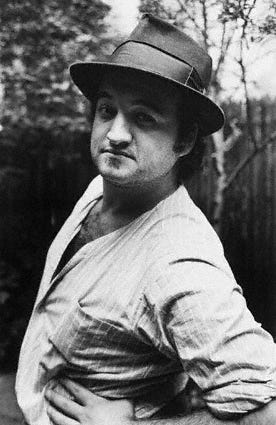60 Morton: John Belushi’s West Village “Reich Palace”
Visiting 60 Morton Street, the SNL legend’s last home
Like just about any other house in NYC’s West Village, 60 Morton Street has a storied past you probably wouldn’t imagine at first glance. Down the block, The Talented Mr. Ripley author Patricia Highsmith wrote (and set) stories on this street she called home. Across the way, Julius Rosenberg kept his spy den. But if you walked by 60 Morton on the right day in the mid-’70s, you might have spied a sliver of pop culture history: the Blues Brothers’ Bluesmobile parked out front. Another day, five years later, you might’ve seen a funeral procession for one of comedy’s biggest stars.
It was 60 Morton Street that John Belushi called home in his final years.
The Saturday Night Live star lived here with his wife, Judy Jacklin Belushi, beginning around 1977. (Jacklin, aka Judith Belushi-Pisano, passed away this past July.) In fact, the Belushis actually made the move from their previous place at 376 Bleecker Street using the Bluesmobile.
In recent years, online sources have taken to claiming the couple lived at 64 Morton Street, but it was actually 60 Morton. Bob Woodward cites the address in his controversial 1984 biography of Belushi, Wired (which, in turn, became an even more ill-received movie).
“Two floors of a nineteenth-century brownstone with sixteen-foot ceilings, elegant chandeliers, and marble fireplaces,” describes author Daniel de Visé in his book The Blues Brothers. “It cost $1,650 a month. Dan [Aykroyd] called it the Reich Palace.”1
Woodward’s Wired describes the layout. “On the first floor, which was really the basement level, John and Judy had their bedroom. Next to it John has a room he called the vault, a large music room with sophisticated stereo equipment and soundproofing on the walls and door.” Upstairs was “the main parlor floor, where there was a large living room and dining room.”2
Many of Belushi’s pals and entourage members passed through 60 Morton over the years, from Aykroyd to Richard "Smokey" Wendell, a former Secret Service agent who had gone from guarding Nixon to watching over Belushi in an attempt to stem his substance abuse. In town to play SNL in 1978, Mick Jagger and Keith Richards jammed the blues in The Vault with John and Judy.3

But about a half-decade after Belushi moved into the home, Aykroyd visited 60 Morton under the worst of circumstances.
On March 5, 1982, Belushi died at the Chateau Marmont in Los Angeles. Jacklin was home on Morton Street at the time.
The news reached Aykroyd that morning, by way of Bernie Brillstein. Aykroyd was in their office at 150 5th Ave. in Manhattan, working on the script for Ghostbusters. He raced downtown on foot to tell Judy before she could hear it from the press.
Aykroyd recounts the tragic morning in the recent Audible audio documentary, Blues Brothers: Arc of Gratitude. “Running down the entire length of Fifth Avenue to their townhouse on Morton Street,” he explains, “my tracks were stopped cold by the bundle of New York Post newspapers hitting the sidewalk at a newsstand. The headline: ‘Belushi Dead at 33.’”4
“I knew if I stopped for a second,” Aykroyd told de Visé, “I would lose it.” ¹
“Arriving at Judy’s house,” he added in Arc of Gratitude, “I burst in and saw that she was standing at her fridge, and did not know yet.” ⁴
Jacklin recalled hearing Aykroyd pushing the push-button lock on the front door, letting himself in. “And then Danny came in. I just knew something was wrong by the way he was standing,” she remembered. ⁴
“Is it John?” she asked him.
Dan struggled to answer. She asked if John had been hurt.
“No, honey,” he told her. “He’s dead.”
On March 11, two days after Belushi was buried in Massachusetts, a funeral procession left from the Morton Street home, down to his Blues Bar (a bar he co-owned with Aykroyd in Tribeca), then north past the Fifth Avenue office they shared, past the home of SNL at 30 Rock, and through Central Park, finally stopping at the Cathedral of St. John the Divine, where roughly 1,000 friends and family had gathered for a memorial service. ⁴
I walked down Morton Street to and from my dorm every day for the better part of 2 years. Every time I did—despite all the other anecdotes of history, movie scenes, and celebrity real estate that stirred in my brain—all I could really think about was Aykroyd reaching that front door, breathless.
For other history on 60 Morton, I recommend checking out this piece from Daytonian in Manhattan.
Daniel de Visé, The Blues Brothers: An Epic Friendship, the Rise of Improv, and the Making of an American Film Classic (Atlantic Monthly Press, 2024)
Bob Woodward, Wired (Simon & Schuster, 1984)
Doug Hill and Jeff Weingrad, Saturday Night: A Backstage History of Saturday Night Live (Beech Tree Books, 1986)
Dan Aykroyd, Blues Brothers: The Arc of Gratitude (Audible Originals, 2024)






